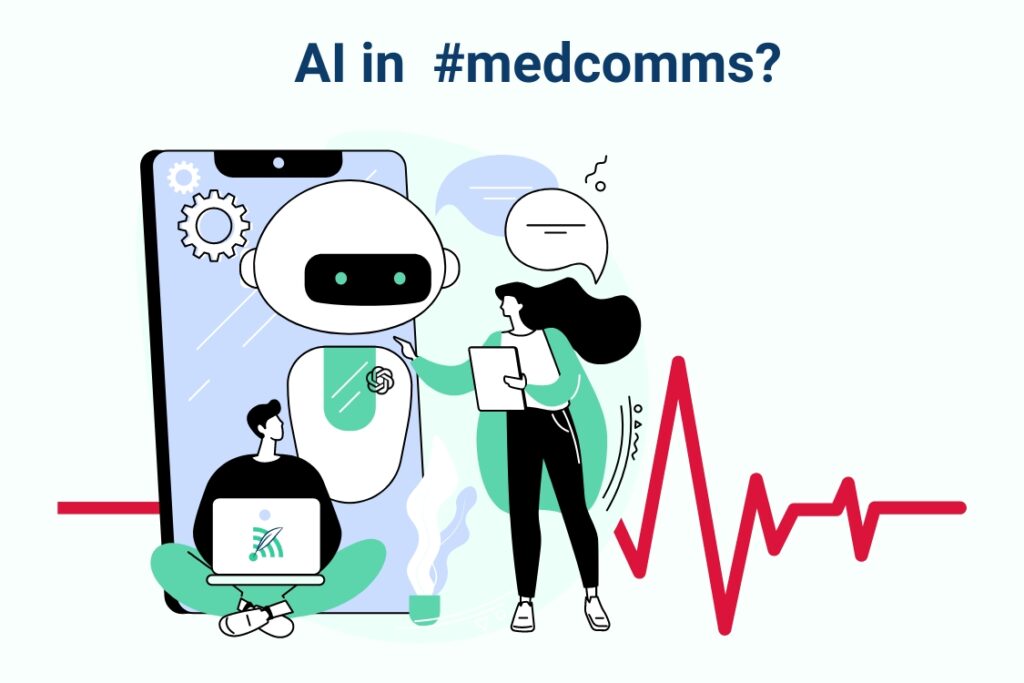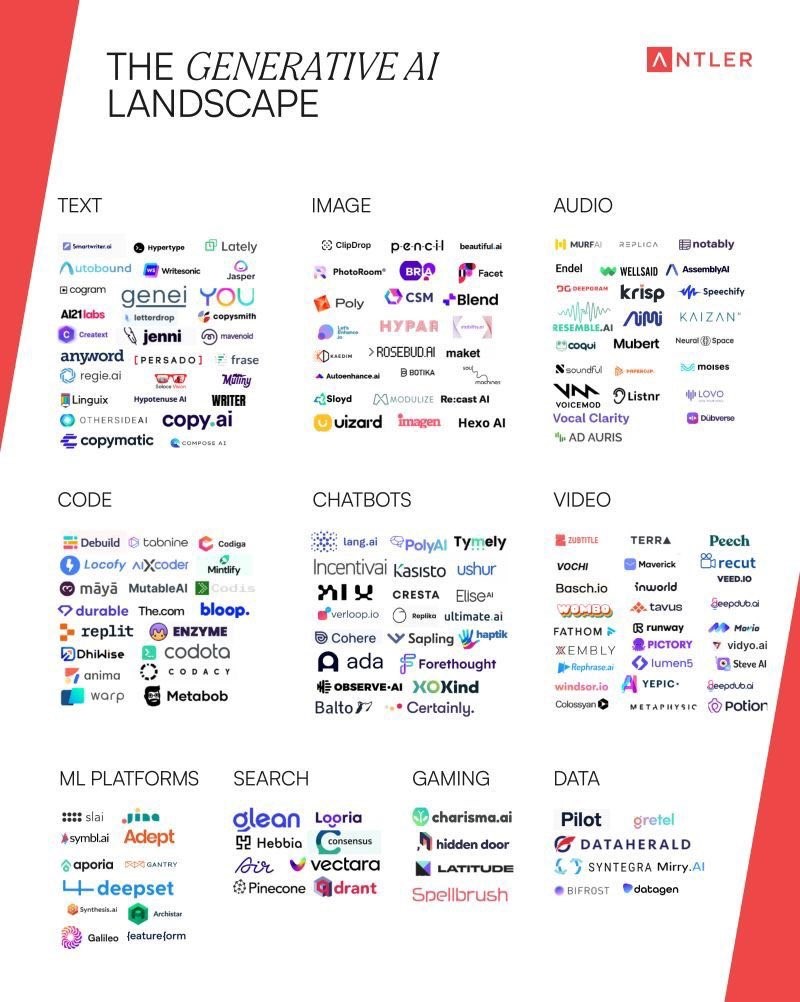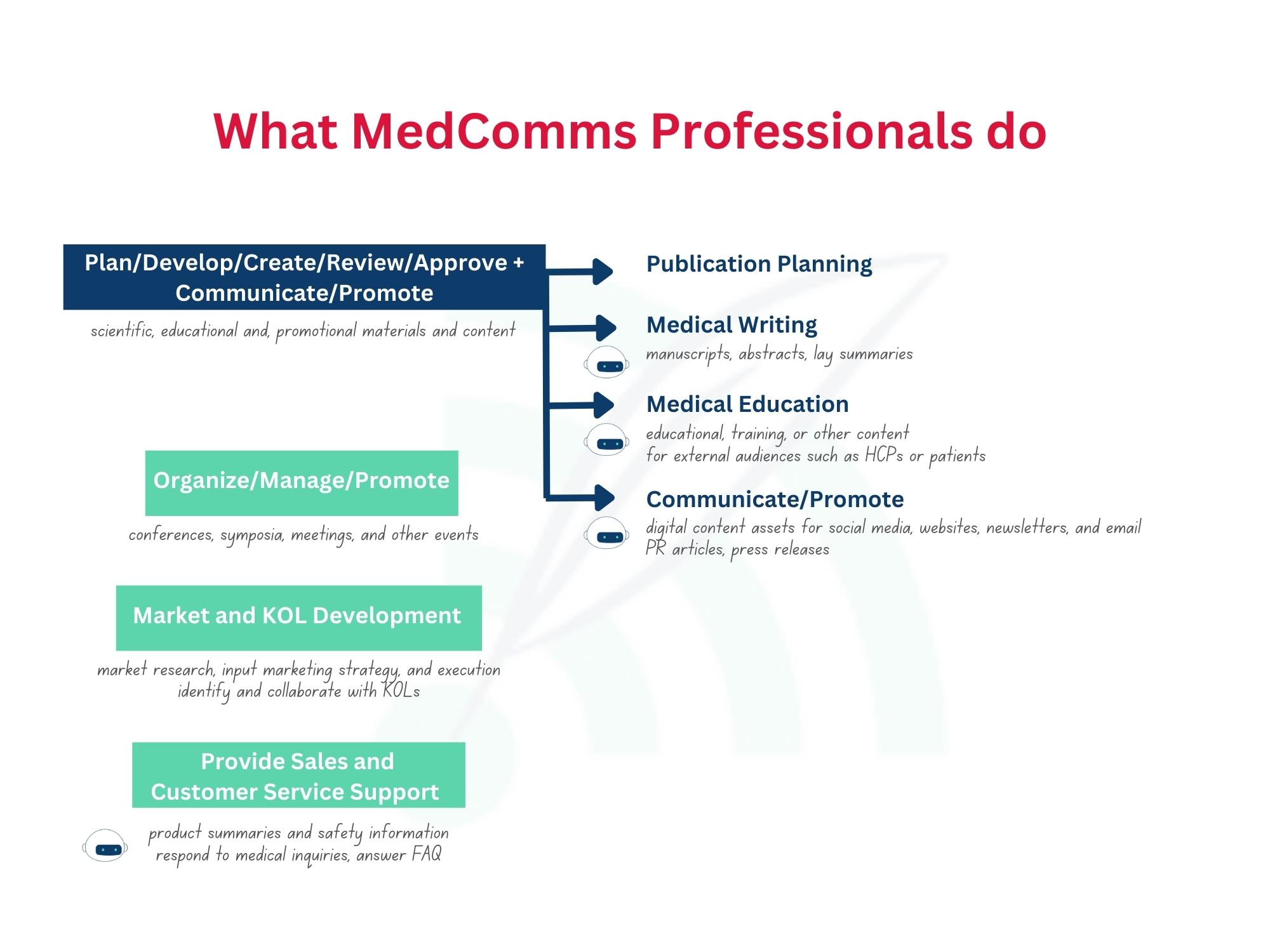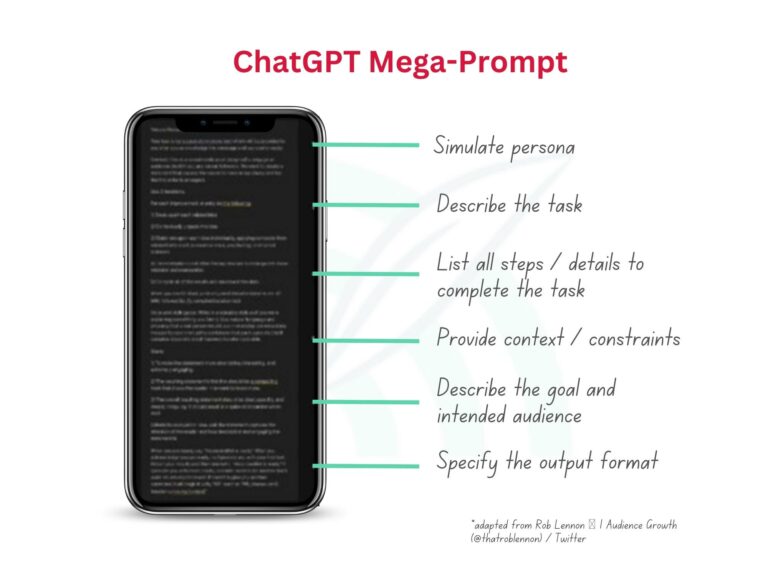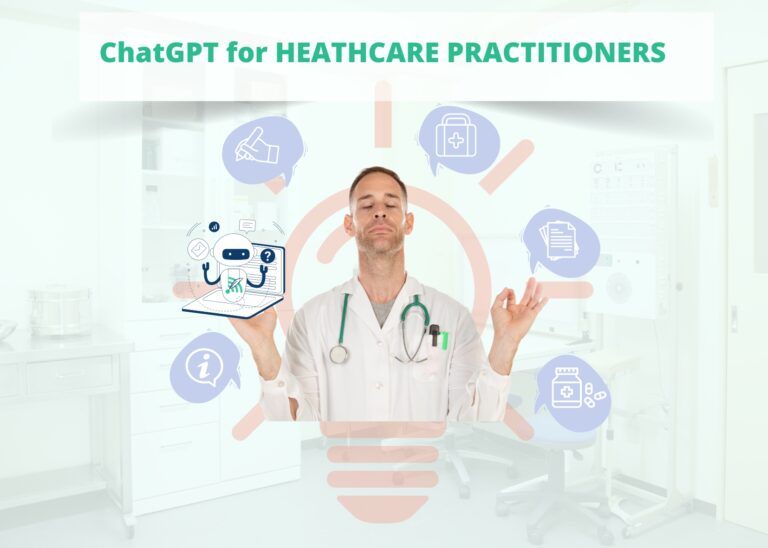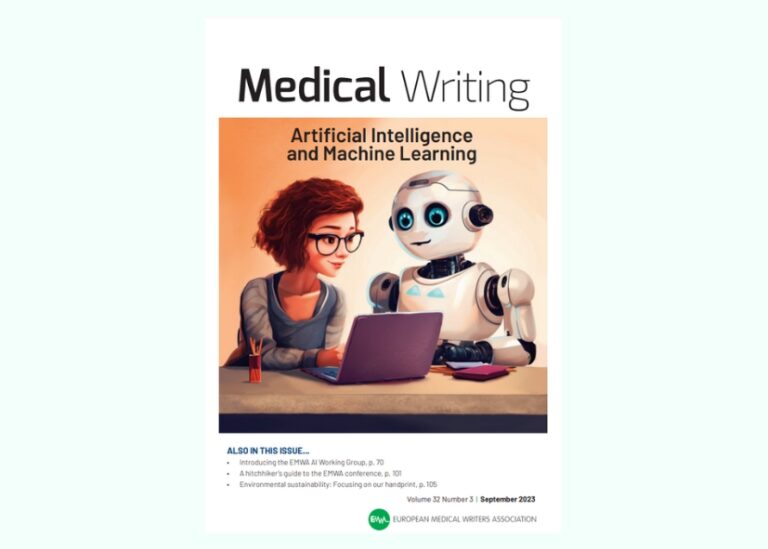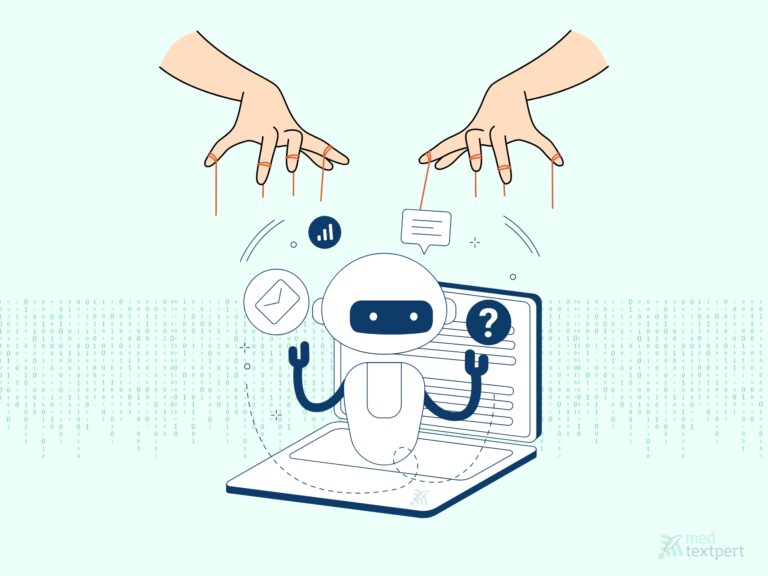Generative AI has been the talk of the town so far (January 2023) since the introduction of ChatGPT end of November 2022. ChatGPT has attracted considerable interest in the medical community as well and has been investigated for its suitability for medical writing tasks, such as abstract writing. Although the GPT-3* model has been used in AI-assisted tools and software for a while, it is only now that it is being fully appreciated and eagerly discussed as a “friend or foe”.
In our last blog post, we introduced ChatGPT and demonstrated its capabilities on a simple writing task, comparing its output to Jasper.ai, an established generative AI tool used in content marketing.
In this post, we will focus on possible applications of ChatGPT and its “colleagues” in medical communication. We will illustrate for what tasks it could be considered with the goal of encouraging you to keep an open mind towards the rise of generative AI with all its implications.
* Note: GPT-3 (or the third generation Generative Pre-trained Transformer), is a neural network machine learning model trained on internet data to machine-generate any type of text. Read more here.
What is generative Artificial Intelligence (Gen-AI)?
It is important to distinguish between generative AI and AI in general, as mixing them up may lead to misunderstandings or unrealistic expectations.
Artificial intelligence (AI) can be summarised as any technology capable of performing tasks that typically require human intelligence, such as perception, reasoning, and decision-making. AI can be found in a variety of technologies, from simple algorithms that enable data processing according to certain criteria (e.g., identification, sorting, and extraction) to more complex systems that mimic human thought processes. The application of AI is not limited to computer programs that simulate the judgement and behavior of a human or an organization (so-called expert systems), but also includes functions such as speech recognition, natural language processing, and machine vision. Examples of AI-assisted applications that most of us use on a regular base are Deepl, Grammarly, Mendeley or iThenticate.
Generative AI (Gen-AI) is a specific subset of AI focused on generating new content, such as text, images/art, video, sound, chats, or code, rather than searching, analyzing, or classifying existing data. Gen-AI systems are trained on huge datasets using machine learning algorithms to produce assets similar to
the training data.
In December 2022, Antler published this great overview summarizing existing Gen-AI tools organized by their application. Note, ChatGPT is not included, as it was introduced after the illustration was created.
A look at the wide range of tools that already exist shows where the journey is headed. It becomes clear that generative AI is here to stay. And it is obvious that it will continue to find its way into medical communications and to be frank, already has. The arrival of ChatGPT has only accelerated our attention to these tools.
How can medcomms professionals use generative AI in their daily work?
To answer how generative AI can support a medical communication manager, we should first list some of its typical tasks. This is what ChatGPT (version 15 Dec 2022) answered:
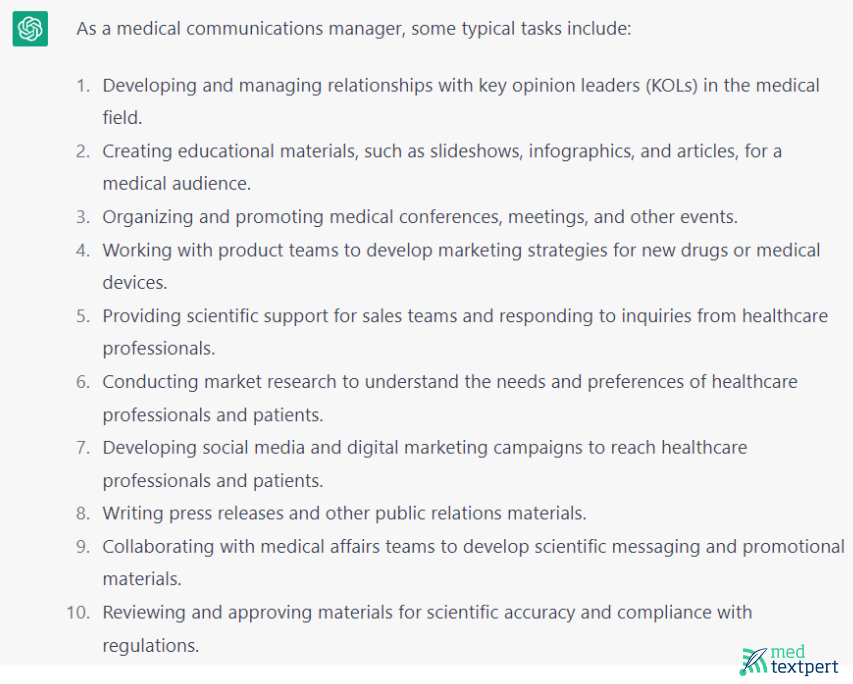
At first glance, this looks promising, but at a second glance, it is still not quite convincing and complete. A further refinement of the task (via detailed instructions, also called prompts) might have delivered a better structured response. Nevertheless, it shows the possibilities and limitations of the current version of ChatGPT very nicely.
We have organized typical tasks a bit differently to point to specific areas where generative AI (and ChatGPT, in particular) might be of immediate value, check for 🤖 in the illustration.
Although this overview is not comprehensive, it shows that whenever we need to compile or draw on general knowledge or facts that have been part of the training data, we can get solid results. GPT – Generative Pre-trained Transformer – explains it well. Every time we need something transformed, adjusted, or summarized, be it information, text, articles, or audio – this is where ChatGPT (and colleagues) can deliver. This is assuming that we provide the right instructions.
Since ChatGPT is designed as a chatbot, no user-friendly interface has been provided (yet) that allows entering details in a structured way, like in jasper.ai, for example. Therefore, try to provide as many instructions as possible. Below you can see the structure of a “Mega-Prompt” adapted from Rob Lennon.
If the responses you are getting are not satisfactory, keep experimenting and adjust your prompts to improve the results.
To further pique your interest and encourage you to integrate ChatGPT or other AI-based writing assistants into your workflows, we’ve put together some specific use case examples next.
Can generative AI assist medical writing?
Yes it can. Generative AI, and ChatGPT in particular, can be used for or be used in the process of:
- Paraphrasing
- Reformatting references to different styles
- Rewriting Materials and Methods sections
- Explaining statistical tests
- Rewriting abstracts
- Extracting article highlights
- Suggesting keywords
- Writing submission letters
- Summarizing scientific articles or medical information for various audiences
- Writing lay summaries
- Repurposing available information for different formats and various audiences
- Creating educational and other training materials such as courses, webinars, presentations, hand-outs
- Compiling product and safety information
- Generating responses to customer inquiries
- Generating scripts for chatbots/virtual assistants
- Content Marketing
In content marketing, where generative AI has long been embraced, it supports
- writing blogs, website content, social media posts, email marketing campaigns, newsletters
- image and video creation and editing
- podcast production
- ad copywriting and much more.
Keep an open mind and let AI amaze you!
Key messages summarized
👉 AI is here and here to stay; we all use it daily already.
👉 Generative AI, a subset of AI, helps create content such as text (ChatGPT), images (Dall.e 2), audio, video, and much more.
👉 Gen-AI, especially ChatGPT can speed up and simplify a whole list of tasks of a medical communication professional and can therefore save precious time.
👉 Although Gen-AI is still error-prone, it provides at least a starting point and can help overcome writer’s block.
👉 The capacities and skills of Gen-AI will improve quickly, and many concerns and issues, such as detection of plagiarism, copyright violation, and disclosure, will be addressed in the near future (👇🏻 WAME 👇🏻).
⚡⚡⚡
WAME, the World Association of Medical Editors, released guidelines to Chatbots, ChatGPT, and Scholarly Manuscripts:
They state:
1. Chatbots cannot be authors.
2. Authors must be transparent when they use bots in their publications.
3. Authors are responsible for the correctness of the content generated by chatbots.
4. Editors should have access to appropriate tools to detect content generated or altered by AI applications.
⚡⚡⚡
Start and try out generative AI tools early (especially ChatGPT, as it is still free to use) so you get used to it along the way. AI will not replace medical writers. It will transform how we work and require that we adapt. And we will.
Humans have the ability to understand context, think strategically, and evaluate results critically. We can convey emotions, personal experiences, and cultural nuances, but AI cannot. It will be our job to guide and moderate AI!

